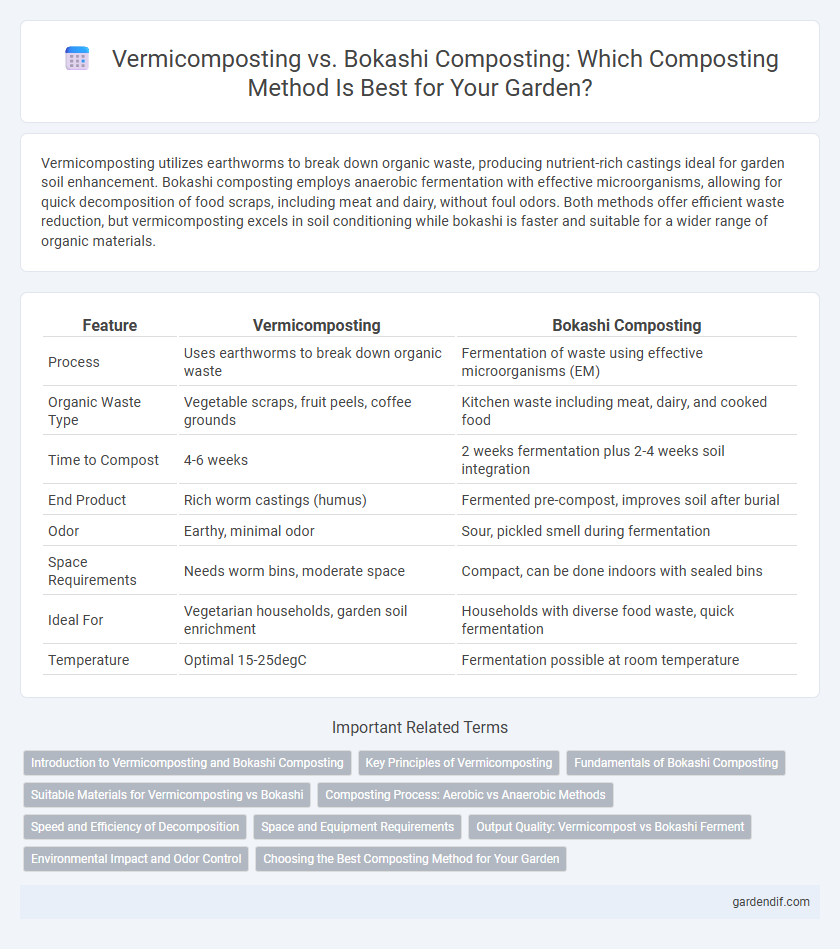
Vermicomposting vs Bokashi composting Illustration
Vermicomposting utilizes earthworms to break down organic waste, producing nutrient-rich castings ideal for garden soil enhancement. Bokashi composting employs anaerobic fermentation with effective microorganisms, allowing for quick decomposition of food scraps, including meat and dairy, without foul odors. Both methods offer efficient waste reduction, but vermicomposting excels in soil conditioning while bokashi is faster and suitable for a wider range of organic materials.
Table of Comparison
| Feature | Vermicomposting | Bokashi Composting |
|---|---|---|
| Process | Uses earthworms to break down organic waste | Fermentation of waste using effective microorganisms (EM) |
| Organic Waste Type | Vegetable scraps, fruit peels, coffee grounds | Kitchen waste including meat, dairy, and cooked food |
| Time to Compost | 4-6 weeks | 2 weeks fermentation plus 2-4 weeks soil integration |
| End Product | Rich worm castings (humus) | Fermented pre-compost, improves soil after burial |
| Odor | Earthy, minimal odor | Sour, pickled smell during fermentation |
| Space Requirements | Needs worm bins, moderate space | Compact, can be done indoors with sealed bins |
| Ideal For | Vegetarian households, garden soil enrichment | Households with diverse food waste, quick fermentation |
| Temperature | Optimal 15-25degC | Fermentation possible at room temperature |
Introduction to Vermicomposting and Bokashi Composting
Vermicomposting utilizes earthworms to break down organic waste, producing nutrient-rich castings ideal for enriching garden soil. Bokashi composting employs a fermentation process using effective microorganisms to rapidly decompose food scraps, including meat and dairy, in an anaerobic environment. Both methods offer efficient, sustainable alternatives to traditional composting by accelerating organic matter decomposition and enhancing soil fertility.
Key Principles of Vermicomposting
Vermicomposting relies on specific species of earthworms, primarily Eisenia fetida, to efficiently decompose organic waste through their digestive processes, transforming it into nutrient-rich castings. The key principles emphasize maintaining optimal conditions such as moisture levels between 70-90%, temperatures ranging from 15-25degC, and a balanced carbon-to-nitrogen ratio to support worm activity and microbial interactions. This method accelerates organic matter breakdown, enhances soil fertility, and reduces greenhouse gas emissions compared to traditional composting techniques.
Fundamentals of Bokashi Composting
Bokashi composting relies on anaerobic fermentation using specific microorganisms to break down organic waste rapidly in a sealed environment, creating nutrient-rich bokashi bran as an inoculant. Unlike vermicomposting, which depends on aerobic decomposition through earthworms, bokashi preserves more nutrients and reduces odors during the process. This method is particularly effective for composting cooked foods and dairy, which are typically unsuitable for traditional composting systems.
Suitable Materials for Vermicomposting vs Bokashi
Vermicomposting is best suited for processing fruit and vegetable scraps, coffee grounds, eggshells, and shredded paper, as these materials support the health and digestion of composting worms. Bokashi composting efficiently handles a broader range of organic waste, including meat, dairy, cooked foods, and oily substances, due to its anaerobic fermentation process that rapidly breaks down complex materials. Both methods reduce landfill waste, but selecting vermicomposting or Bokashi depends on the type of organic waste available for composting.
Composting Process: Aerobic vs Anaerobic Methods
Vermicomposting utilizes aerobic decomposition, relying on earthworms and aerobic microbes to break down organic waste with ample oxygen, resulting in nutrient-rich castings. Bokashi composting employs an anaerobic fermentation process using specific microorganisms in an oxygen-free environment, preserving more nutrients and enabling fast decomposition of food scraps. The aerobic method in vermicomposting typically produces less odor and requires aeration, while the anaerobic bokashi process generates a fermented pre-compost that requires further decomposition in soil.
Speed and Efficiency of Decomposition
Vermicomposting accelerates decomposition by utilizing earthworms that rapidly break down organic waste into nutrient-rich castings within 2 to 4 weeks. Bokashi composting employs anaerobic fermentation with effective microorganisms, allowing food waste, including meat and dairy, to ferment in as little as 1 to 2 weeks before further composting. Vermicomposting excels in producing high-quality compost efficiently for garden use, while Bokashi offers faster initial breakdown and greater versatility in waste types.
Space and Equipment Requirements
Vermicomposting requires a worm bin and red wiggler worms, making it ideal for small indoor spaces with controlled moisture and temperature. Bokashi composting demands an airtight fermentation container and Bokashi bran, suitable for compact kitchens and apartments due to its odorless, anaerobic process. Both methods minimize space but differ in equipment complexity and maintenance needs.
Output Quality: Vermicompost vs Bokashi Ferment
Vermicomposting produces nutrient-rich vermicompost, high in beneficial microorganisms and plant-available nutrients, enhancing soil structure and fertility. Bokashi ferment yields a pre-compost enriched with lactic acid bacteria that accelerates organic matter breakdown but requires further soil integration to complete decomposition. Vermicompost offers immediate, stable soil amendment, whereas Bokashi output serves as a fermentation-stage product needing additional processing to become mature compost.
Environmental Impact and Odor Control
Vermicomposting uses earthworms to break down organic waste, resulting in nutrient-rich compost with minimal odor due to the worms' digestion process. Bokashi composting employs anaerobic fermentation through beneficial microbes, effectively reducing odors and allowing composting of meat and dairy that vermicomposting cannot handle. Both methods significantly decrease landfill waste and greenhouse gas emissions, but Bokashi excels in odor control during the initial breakdown phase.
Choosing the Best Composting Method for Your Garden
Vermicomposting uses earthworms to break down organic waste, producing nutrient-rich castings that enhance soil health and promote plant growth, making it ideal for small-scale, indoor, or cold climates. Bokashi composting employs anaerobic fermentation with effective microorganisms to rapidly decompose food scraps, including meat and dairy, resulting in a pre-compost that enriches soil microbial activity and improves garden soil structure. Selecting the best method depends on garden size, waste type, climate conditions, and desired compost quality, ensuring optimal nutrient recycling and sustainable soil management.
Vermicomposting vs Bokashi composting Infographic

 gardendif.com
gardendif.com